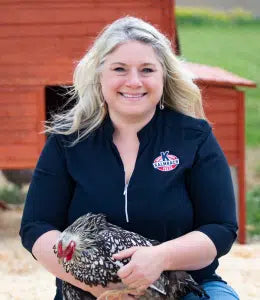What Are the Differences in Starter & Grower Phases in Chickens?

There are three primary growth phases that most backyard chickens are going to go through – the starter phase, the grower phase, and the layer phase. In this article, we are going to concentrate on the starter and grower phases. We will learn what physiological functions take place in the starter and grower phases, how to feed chicks during these two phases, and what management practices to implement during each phase.
The Starter Phase
The first weeks of a chick’s life are referred to as their Starter Phase. Depending on chicken breed, the starter phase is between hatch and 3-5 weeks of age. Lots of very important physiological processes are happening in the starter phase. That tiny little chick has to start developing their digestive tract and digesting food. They also have to start developing and establishing their immune function. And, most obvious to us, they have to start putting on their feathers which are crucial for temperature regulation. Very generically-speaking, I always describe the starter phase as “before feathers.”
The Grower Phase
Following the starter phase, a chick will go through their grower phase. Chicks intended to become laying hens will go through the grower phase from about 5 weeks of age until 4 months of age, which is when sexual maturity starts. Meatbirds will go through their grower phase from 3 weeks of age until harvest, which usually happens around 6-8 weeks of age. During the grower phase, a chick has to hone their digestive process. They will also work on establishing a stronger immune system and maintain all of the work they did in the starter phase. During the grower phase, they must also do an incredible amount of growing. Very generically-speaking, I always describe the grower phase as “after feathers.”
How Do I Choose the Right Feed for the Starter and Grower Phases?
In recent years, it has become quite common to find one feed that can be used in both the starter and the grower phases. This feeding strategy removes the need to manage inventory and switch feeds. A combination starter-grower feed also makes feeding a lot easier. If you are raising chicks that will become laying hens, getting your babies off to a strong start will help them become thriving and healthy adult birds. The vast majority of people that buy baby chicks for backyard production intend for those chicks to become laying hens. Our 18% All Natural Start Right® Chick feed and Chickhouse Reserve® are perfect feeds for chicks in both the starter and grower phases of life. If you are raising meatbirds, you will want to look for a starter-grower feed that is high in crude protein and amino acids. Meatbirds grow at an incredible rate and they need a lot of energy, protein, and amino acids in order to build that muscle mass. Our 22% Start-to-Finish Meatbird is the best option for feeding large-bodied broiler chickens for harvest. If you would like information about choosing the right starter and grower feeds for ducks, geese, or turkeys, please check out our article Nutritional Needs of Mixed Flocks with Baby Birds.
Should I Choose a Medicated Chick Feed?
Medicated feed options are most popular in starter and grower feeds. When a chick hatches, it has a very immature immune system. Mammals get some innate immunity from their mothers during gestation and they also get antibodies from colostrum (the mother’s first milk). Baby chicks do not get these advantages. When that chick hatches, it has to start developing its immune system almost from scratch. Since these chicks are at their most vulnerable during the first few weeks, it’s quite common to see medicated starter and grower feeds. The vast majority of medicated starter feeds are going to be medicated with Amprolium. Amprolium is a coccidiostat that is used either for the prevention or for the treatment of coccidiosis. Coccidiosis is intestinal protozoa – microscopic parasites – that can develop in the digestive tract of the chicks. Because their immune system is not well established yet, younger chicks are more susceptible to the negative effects of coccidiosis. Sick chicks will look lethargic, unthrifty, and will not gain weight well. If the infection is severe, the chicks could die. Amprolium in feed is almost always used at the preventative levels.
